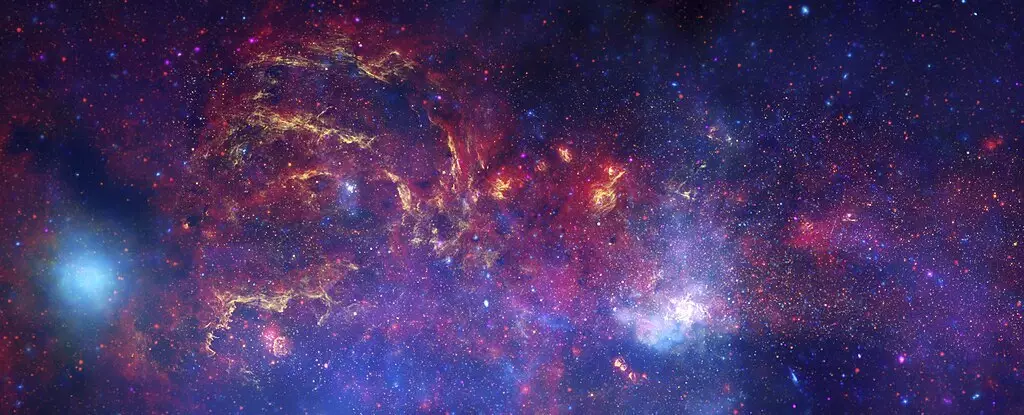Dark matter remains one of the most perplexing phenomena in modern astrophysics, a mysterious entity that accounts for approximately 85% of the universe’s matter yet remains invisible to us. While scientists have been on a relentless quest to uncover its secrets, their endeavors have largely been met with frustration. Recent research, however, hints that we may be closer to understanding this conundrum, particularly through the lens of the Milky Way’s Central Molecular Zone (CMZ). This dense region rich in molecular hydrogen might harbor clues that could revolutionize our comprehension of dark matter.
The universe is a complex tapestry of galaxies, stars, and cosmic events, yet the unseen force of dark matter shapes it in ways we are only beginning to appreciate. The gravitational influence of dark matter can be observed in the movement of galaxies and the structure of the cosmos, yet its non-interaction with light makes it utterly elusive. As theoretical physicist Shyam Balaji muses about the potential lighter nature of dark matter, one can’t help but feel a spark of hope that we might finally begin to crack this cosmic code.
The Central Molecular Zone: A Laboratory for Discovery
The CMZ serves as a unique laboratory for studying dark matter, occupying a significant part of our galaxy’s core. It is an intricate region where nearly 80% of the Milky Way’s dense gas is concentrated, within frigid clusters known as molecular clouds. These clouds, characterized by their incredible densities, are not just passive reservoirs but dynamic environments where new molecules are formed and stellar beginnings unfold—making the CMZ a fascinating hotspot for both stellar and dark matter research.
Given its unique characteristics, the CMZ presents a peculiar anomaly: a positive charge observed in what is generally expected to be neutral hydrogen gas. This anomaly begs an explanation, pushing researchers to consider potential interactions that might arise from dark matter. The concept that this charged state could be induced by lighter forms of dark matter challenges the traditional perception, thus opening new avenues for investigation.
Rethinking Dark Matter Candidates: Beyond WIMPs
Historically, the field of dark matter research has been heavily focused on a specific class of hypothetical particles called Weakly Interacting Massive Particles (WIMPs). These particles have dominated the narrative as primary candidates in the search for dark matter due to their predicted properties of weak interactions and substantial mass. However, the ongoing lack of evidence for WIMPs has prompted a broader perspective on what dark matter might be.
The recent analysis by Balaji and his colleagues suggests moving beyond the WIMP-centric approach to explore a broader spectrum of dark matter candidates. Lighter particles, which may have minimal connections to the known universe, could offer a more accurate representation of what we are witnessing in the CMZ. This paradigm shift paves the way for exploring a richer array of dark matter theories, including novel candidates that sit outside our current understanding of particle physics.
The Role of Energy in the Mystery of Ionization
A critical aspect of Balaji’s study is the examination of energy signatures emanating from the CMZ, potentially linked to lighter dark matter particles. The premise revolves around a groundbreaking concept: as these lighter dark matter particles collide, they may produce oppositely charged particles that, in turn, create ionization events in hydrogen gas. This could lead to the formation of positively charged clouds in the CMZ, thus providing a tangible link between observations and dark matter’s properties.
This exploration challenges previous assumptions regarding cosmic rays as the primary source of ionization in such environments. The energy profiles measured from the CMZ appear to contradict that narrative, suggesting that the underlying phenomenon is significantly different from what current models propose. Balaji’s findings encourage scientists to rethink earlier models, advocating for an exploration of processes that may be slower and less massive than previously considered.
A Call for Broader Exploration
In a world where experiments predominantly tether scientists to Earth, Balaji’s assertion resonates: the search for dark matter must extend beyond conventional boundaries. As scientists strive to tease apart the enigmatic threads of dark matter from the fabric of the universe, they are reminded of the potential richness of the cosmos that remains uncharted. The Milky Way’s CMZ could serve not just as a focal point for studying dark matter but as a clarion call to expand our investigative horizons.
The interplay between dark matter and visible matter offers tantalizing possibilities, and the burgeoning research in this field might lead to groundbreaking insights. The exploration of lighter dark matter particles may not only furnish a deeper understanding of cosmic phenomena but could also ignite a revolution in fundamental physics itself. The quest to understand this unseen force is not merely about defining particles, but about embracing the vast mysteries of the universe waiting to be unraveled.

